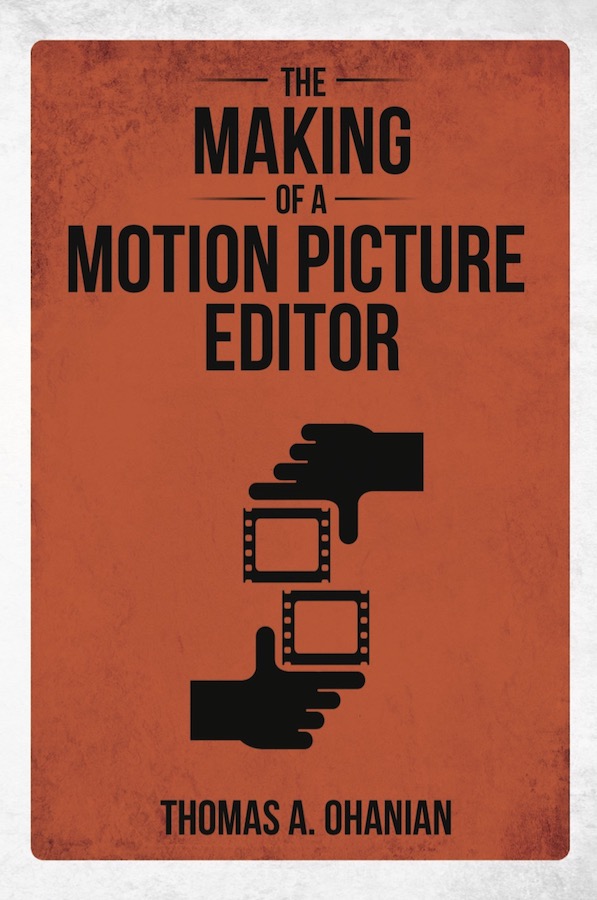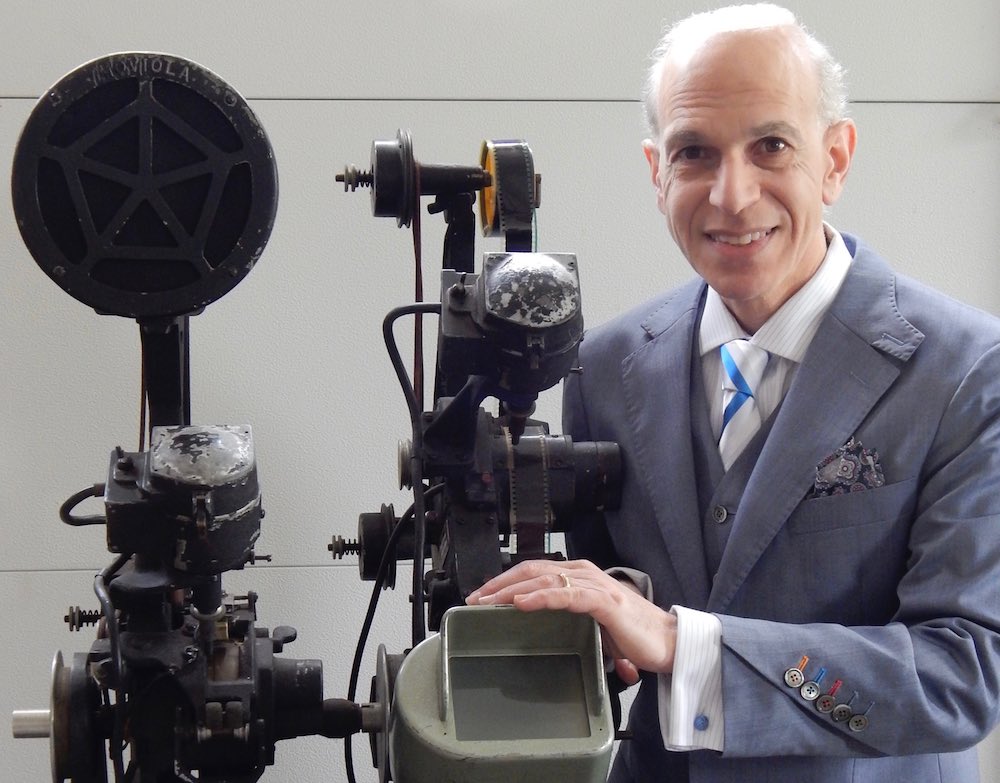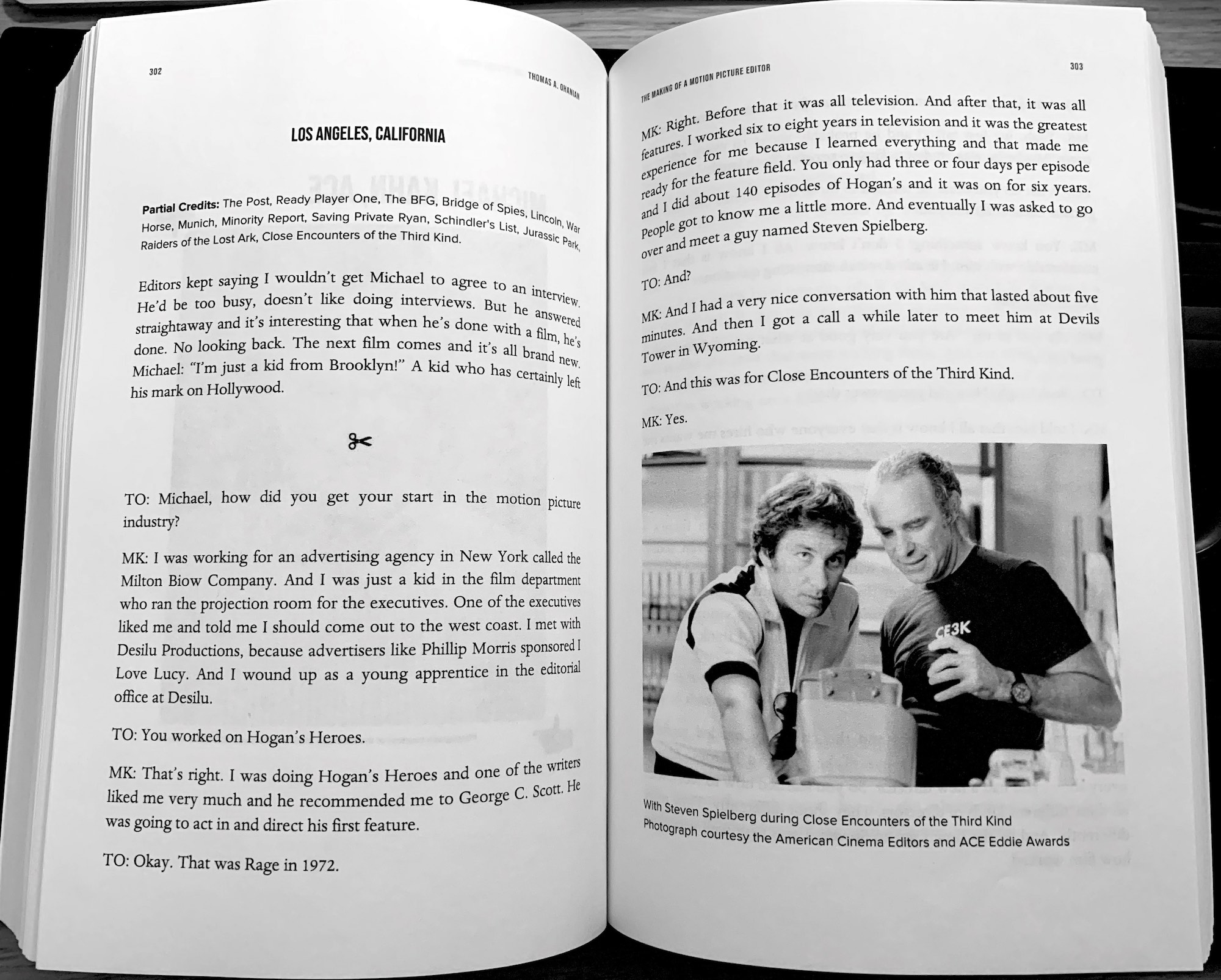The Making of a Motion Picture Editor – A Film Editor’s Review
- The Making of a Motion Picture Editor Book Review
- Author Thomas Ohanian in Conversation
- My Favourite Quotes from The Making of a Motion Picture Editor
The Making of a Motion Picture Editor by Thomas A. Ohanian is a 560 page journey through the history of film editing in the past half-century or so, as seen through the eyes of the editors who cut some of American cinema’s most popular and influential films.
Films like; A Perfect World, American Graffiti, Apocalypse Now, Apollo 13, Birdman, Black Hawk Down, Bonnie and Clyde, Close Encounters of the Third Kind, Dog Day Afternoon, Ferries Buellers’ Day Off, Fight Club, Gladiator, Heaven’s Gate, Jacob’s Ladder, JFK, Jurassic Park, Lawrence of Arabia, Leon: The Professional, Man on the Moon, Marathon Man, Minority Report, Network, One Flew Over The Cuckoo’s Nest, Out of Sight, Raiders of the Lost Ark, Saving Private Ryan, Slumdog Millionaire, Star Wars, Taxi Driver, The Fellowship of the Ring, The French Connection, The Hurt Locker, The Matrix, The Right Stuff, The Social Network, Traffic, WarGames, Who Framed Roger Rabbit…
Cut by editors such as; Dede Allen ACE, Kirk Baxter ACE, Richard Chew ACE, Anne V. Coates ACE, Steven Cohen ACE, Joel Cox ACE, Chris Dickens ACE, William Goldenberg ACE, Gerry Hambling ACE, Richard A. Harris, Michael Khan ACE, Lynzee Klingman ACE, Stephen Mirrione ACE, Walter Murch ACE, Tom Rolf ACE, Christopher Rouse ACE, Pietro Scalia ACE, Arthur Schmidt ACE, Jamie Selkirk, Michael Tronick ACE, Angus Wall ACE, Martin Walsh ACE…
If that reads like a whose-who of Academy Award winning editor’s that is because that’s precisely how the book started life, as an attempt to interview and record the personal experiences of every Academy Award winning editor alive today.
At the time of this writing, the editors who are interviewed in this book have been involved in films that have won a staggering 360 Academy Awards and received an additional 785 nominations!
And it’s also one of the book’s greatest strengths because it delivers a phenomenal breadth of content along side an intimate ‘oral history’ of over 50 film editors personal experiences after decades of working in the industry.
What you are about to read are the recollections, learnings and guidance from some of the world’s finest motion picture editors.
If you don’t know their names, you’ll know the films. And I hope that you will seek out those films you haven’t seen, now that you know what went into making them from an editor’s viewpoint.
Watch those films if you haven’t seen them – they’re well worth your time. – Thomas Ohanian
Overall, the experience of reading The Making of a Motion Picture Editor, is an addictive one.
Every time you turn to a new interview you discover an editor whose work you admire, and a treasure trove of wisdom on some aspect of the art and craft of living, working and creating in the edit suite.
I’ll share a few more thoughts on the book shortly, but in summary, it’s worthy of a place in your film editing library.
You can buy The Making of A Motion Picture Editor on Amazon’s Global Stores for [amazon_link asins=’1925819566′ template=’PriceLink’ store=’jonelwfiledi-20′ marketplace=’US’ link_id=’7f9177df-14fa-11e9-9b08-d9f43121d7c7′] in paperback, or just $9.91 on Kindle.
Thomas A. Ohanian in Conversation
Author Thomas A. Ohanian didn’t exactly set out to write this book but given his history in the film industry – first as a director of product development at Avid from 1989 to 2001 (he was the eighth employee!), and since then as a consultant and director at numerous media/tech companies, and ‘after decades of meeting some of the most accomplished editors in the world‘ he thought he had access to too much editorial wisdom to let the opportunity slip away, and so six years later, you can now hold a copy of his efforts in your hands.
The book took six years to complete because there were people who were very difficult to track down but who it was very important to me to include.
I think readers will enjoy the things that were first discovered during the course of the process. For example, Anne V. Coates had just found the un-mailed letter [turning down Lawrence of Arabia] five days previously and hadn’t told anyone.
Or the very funny revelation from Thomas Stanford on the dinner with Leonard Bernstein.
It took a year to get to the interview with Marcia Lucas. But she is so under-represented in editing lore that I wanted her to be in the book. Just getting in contact with her was an adventure.
In any case, the book is 1/2 of the manuscript! It would have been 1,100+ pages, but I wanted to keep it as affordable as possible for students.
By the way Thomas also has an Academy Award and 2 Emmys. This is how this article from the Hollywood Reporter describes him:
Ohanian is co-inventor of the Avid nonlinear editing system that led the transition from film-based linear editing to computer-based digital nonlinear editing. For his efforts, he was the recipient of a 1994 Emmy for the Avid Media Composer, a 1995 Academy Award for Scientific and Engineering Achievement for the Avid Film Composer — which was upgraded in 1999 to the Academy Award of Merit, an Oscar statuette — and a 1998 Emmy for the Avid Multi-camera System.
I emailed Thomas a few questions of my own to dig a little deeper into his own career and his perspective on the future of the industry.
Just to talk about your own background, what was it like building Avid from the ground up, and being on the bleeding edge of a tectonic shift in the industry?
What’s interesting about this is that there was a certain assured bravado that we had, despite the fact that we were working on things that had never really before been achieved.
Daisy-chaining 6-7 SCSI hard drives on a Mac bus? We weren’t arrogant, by any means.
It was more the case that we felt that this was too important an endeavour to allow the notion of failure to even enter into our minds. Not that anything here was easy. There were a lot of hurdles and the amount of hours was really incalculable.
But, all of that was rewarding when film editors would come up to me and say, “I was ready to retire. This gave me another ten years on my career.”
What were some of the most memorable moments?
Many moments. The exhilarating moment when we passed a single frame of video through a prototype JPEG hardware chip was quite remarkable. Certainly, the reaction to the product at NAB 1989.
The time I was in Los Angeles and a film editor who was contracted to edit one national beer commercial actually created 18 versions for the advertising agency who was amazed.
Scary? Try going to NAB with JPEG-assisted compression for the first time (1991) and going through the entire show without playing any audio, just images. And no one ever asked about the audio—that was how impressive the difference was between software and hardware compression.
What was it like to win your own Academy Award (not to mention your Emmy’s) for your work on creating Avid Media Composer?
I am fortunate to have received the Academy Award and three Emmys for scientific and technical invention. It’s a well-worn cliché (I didn’t do this for the awards) but it’s true—none of us working on this project ever gave that a thought.
We were really motivated by doing something that was not only hard to do but that could fundamentally make it easier for people to make videos.
The awards are, of course, great but what it meant to me personally was that we had achieved something that fundamentally changed an industry. That I had a role in that effort is very important to me.
Given that you’ve overseen so much change in the industry, what do you think are the most exciting and dominant new developments?
It’s pretty clear that automation is touching so many aspects of our daily lives. So, too, is it the case that automation is applicable to the editing of motion picture images and audio.
How Artificial Intelligence and Machine Learning will affect the content creation process is a rapidly evolving story.
We’ll see image recognition, object recognition, automatic editing of certain types of footage while obeying the conventions of content creation. Automatic content indexing solutions, creating voiceovers by retyping text.
And where this explodes is when choosing in and out points in a video is no longer the model—that time is coming.
What was it like putting The Making of a Motion Picture Editor together? What made you persevere with it for 6 years?
I had been involved in preserving oral testimonies of genocide survivors and also preserving music that was eroding due to tape age. The whole idea of preserving history that people, especially students, could use to learn from has always been something interesting to me.
I was also meeting these great motion picture editors who edited films from the ‘50s, ‘60s, ‘70s, but whose stories had never been told. And, as they were getting older, I felt that time was ticking and that I needed to get their stories told—what could we learn from their experiences?
I can tell you that I never thought it would be six years!
Do you have any plans for a follow up book, or online-companion site, with some of other material that didn’t make the cut?
There is so much material that making more of it available as well as audio clips is something I definitely want to pursue. I think, regarding a follow-up—there are a lot of other themes that could be explored.
Thanks Tom for your time!
The Making of a Motion Picture Editor – An Editor’s Review
The joy of reading The Making of a Motion Picture Editor is that every time you finish one of its 51 short interviews and turn the page to start another, you stumble across the perspective and experience of someone whose work you admire, whose career has shaped your understanding of cinema and from whom you can learn a lot about the art, craft and business of film editing.
It’s such an addictive read, because there are just so many interviews with so many great editors. And whether or not you sit and read for hours or simply dip in and out of different chapters with various famous editors, you’ll enjoy yourself.
Each interview has at least a nugget or three of interesting anecdotes on the production of numerous cinematic classics, as well as the trials and travails of each editor as they find their way into, and stay in, the industry, and this is some of the best content in the book.
Although, in a few places, it feels like some more depth and details would have been warranted. For example, Steve Cohen’s discussion of using an early version of Avid Media Composer, to me was fascinating, but the interview swiftly moves on after just a couple of questions.
These feel a little like a jump cut, but without any visual indication that the conversation is switching topic. Possibly adding in a visual marker between questions would have helped to smooth out the segments.
(Director) Martha Coolidge and I did another show called Angie, and again I used early beta [Avid] software.
A lot of the features that editors now take for granted were developed during that period; JKL trimming, asymmetrical trimming, replace edit, and many other things that I advocated for and helped design.
Steven Cohen ACE (15 Minutes, The Bridge (5 TV episodes), Bosch (15 TV episodes)
Many of the editors interviewed in this book cut their teeth editing on 35mm film and then made the gargantuan leap to digital editing. When reading this quote from Steve Cohen about using an early version of Avid Media Composer – a world in which JKL trimming didn’t even exist! – it makes me question whether modern editors have the same creative and technological courage of their predecessors!
We seem to moan gratuitously about switching from one fully-fledged NLE to another fully-fledged NLE with slightly different shortcuts or functional paradigms. Has our digital comfort made us complacent?
It would seem natural to compare The Making of a Motion Picture Editor to something like The Art of The Cut, by Steve Hullfish, as they’re both relatively recent compilations of interviews with editors.
But in reality they’re actually quite divergent and complimentary reads, with AOTC focusing more the process, often in very technical and workflow orientated detail, whilst Ohanian’s book dwells more on the personal experiences and career trajectories of the editors in question.
This focus helps to anecdotally fill in what it’s like to be a successful film editor, whilst AOTC helps you learn their nitty-gritty wisdom.
Either way, both deserve a place on your film editing book shelf!
To balance out this review it’s worth mentioning that The Making of a Motion Picture Editor is not a perfect book.
Although the quality of the printing is excellent for a self-published volume (I couldn’t tell any difference!) there are innumerate typos and simple errors which would have been easily remedied by a copy editor. (I should know, when I paid a copy editor to proof read my own ebook, How to be a Freelance Creative, she sent me back over 1000 corrections!) Although at 560 pages that might not have been a financially viable option for a self-funded project!
So it’s a shame that these haven’t been corrected already, but maybe a little crowd sourcing of fixes would allow each successive printing of the book to be improved, if it is produced through a print-on-demand service?
It’s also slightly annoying that each chapter doesn’t have the name of the editor on the header of each page, so that you can flick through the book and know whose interview you are in. It’s a small thing but I found myself having to flip back to find the title page of a interview, or rely entirely on the contents page to navigate the book. It’s not something that I’ve noticed before, but it’s absence made the user experience a little cumbersome.
The inclusion of an outside editorial voice might also have focused the book better within each chapter, as I personally wish the questions on ‘what are your favourite films’ or ‘whose work do you admire’ could have been removed in favour of other topics or more detail on previous questions.
All that said, The Making of a Motion Picture Editor is a very valuable addition to the small but growing pantheon of film editing books.
It’s an important read for any film editor, especially younger ones, not least to help them acquire a firmer grounding in the history of the craft and of the work of all those pioneers who have gone before them, but to also come to terms with what it takes to build and sustain a life-long career in film editing.
The final lines of the book, from Thomas’ conversation with editor Hughes Winborne ACE (Crash, The Pursuit of Happyness, Seven Pounds, The Help, Guardians of the Galaxy, Fences), deliver some solid advice for anyone looking to get in, stay in or grow in the film industry.
TO: What’s your advice for people starting out who want to get into editing?
HW: After I won the Academy Award (for Crash) I got a lot of requests to give talks at schools. And one of the things that I was asked a lot was how I had gotten to that point and how had I laid out my career. And I said that there was no laying out and that it was a lot of luck and that, more than anything I hung around. I didn’t leave.
TO: You didn’t give up.
HW: Right, I hung around enough that I got lucky.
Buy The Making of a Motion Picture Editor on Amazon Global Stores
Choice Quotes from The Making of a Motion Picture Editor
Richard Marks ACE, (Serpico, The Godfather: Part II, St. Elmo’s Fire, Say Anything, Father of the Bride, Things to Do in Denver When You’re Dead, As Good As it Gets).
Sadly, Richard died on New Years Eve 2018. Thomas mentioned this in an email, saying “We lost the GREAT Richard Marks last week! He was so deserving–what a talent and, gosh, we laughed so much during the interview.”
TO: You were in television. How was the experience?
RM: I worked on a TV series for a couple of episodes. The producer said ‘There are certain rules. We don’t overlap dialogue. We just don’t’.
I started to work on this episode (laughs) and I’m cutting, and I turn to my assistant and say, ‘This is bullshit! I’m gonna cut it the way it needs to be cut! If they don’t like it they’ll fire me!’ And (laughs) they loved it! They loved the episode. – p.363/364
Michael Kahn ACE (every Spielberg movie ever!)
MK: I have to stress you are working with the director – you’re not alone. You’re a team. You collaborate. A lot of editors think we make the film. But we don’t make the film.
TO: You play a role in the filmmaking process.
MK: Right, and I’m proud to be a film editor. I enjoy it and I love to be the right arm of the director. – p.306
For more from Steven Spielberg’s favourite editor, check out this previous post.
Chris Dickens ACE (Spaced (TV), Shaun of the Dead, Hot Fuzz, Slumdog Millionaire, Les Miserables, The Double, Mary Queen of Scots)
“[My] art teachers always said that if you weren’t happy with the work that you should have the courage to scrub out the lines and start again… and that advice stood me in really good stead as an editor because you’re constantly reworking and rewriting and revisiting an ongoing process… you need to have the courage and look at it and say ‘is that right?’
The thing about the film industry is that even if you think it’s right, you may have someone who comes along and tells you that it isn’t (both laugh) and you still have to change it whether you like it or not!
And often you realise that the request is a different way and it may not be your way, but it’s very important to remember that…as an editor it’s absolutely essential to be open-minded. – p.161
Joel Cox, ACE (A Perfect World, Unforgiven, Mystic River, Million Dollar Baby, Gran Torino, Invictus, American Sniper – basically, every Clint Eastwood directed film, ever)
In this part of the interview Joel was discussing director Clint Eastwood’s advice on some editor’s tendency to edit a scene and then come back the next day to take it apart and play with it some more. Clint’s advice? “First instincts, never look back.”
Client Eastwood says “The minute you start second guessing yourself, you’ve taken yourself out of the realm of that fresh approach and there’s something that might be there that you’ll never get again.”
“We’re either filmmakers or we’re not. Clint says ‘We either know what we’re doing. or we don’t.’
We either have a gut feeling or an intuition about making a film or we shouldn’t be doing this.” – p.142/145
Richard A Harris ACE, (The Candidate, Fletch, L.A. Story, Terminator 2: Judgement Day, The Bodyguard, Last Action Hero, True Lies, Titanic)
TO: What are some of the things you’ve learned along the way?
RAH: Patience.Not to be rushed.
Editing, especially with digital formats, is not a video game.
I tell people that they should think about where they are going and what you want to happen with the next scene.
It’s a holdover from when I had to use a pair of scissors. And that’s always been my thing – I know where I’m going.
It’s not about speed and editing fast, it’s about story, and tomorrow. – p.264
Arthur Schmidt ACE, (The Coal Miner’s Daughter, Back to the Future, Who Framed Roger Rabbit, Back to the Future Part II and III, The Rocketeer, Last of the Mohicans, Forest Gump, Contact, What Lies Beneath, Cast Away, Pirates of the Caribbean: The Curse of the Black Pearl)
TO: Did you ever get nervous with a new director? I mean, did the butterflies ever go away?
AS: I don’t think the butterflies and a bit of insecurity ever went away.
I was always concerned as to whether I’d be up to the task on the next one.
Every movie is different from the one that came before it.
The thought of whether I’d be as good on this one as I was on the last one – that was always there.
Every film presents new and different challenges – new story, new actors, often a new director – it forces you to be on your toes all the time. – p.482








